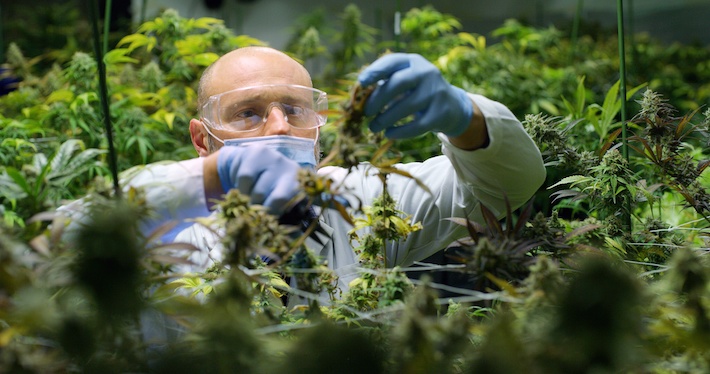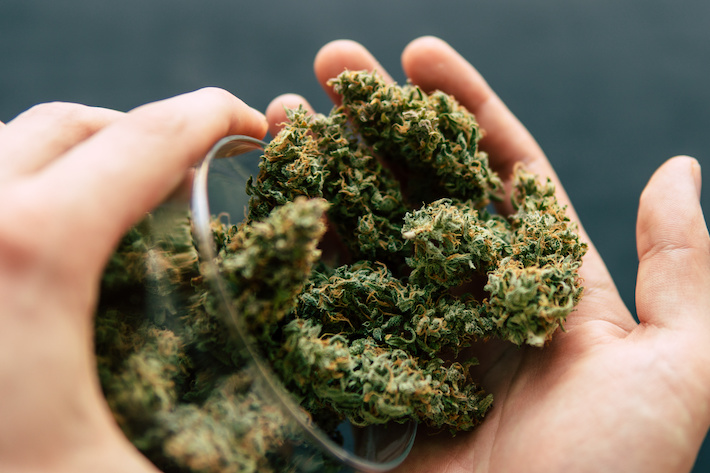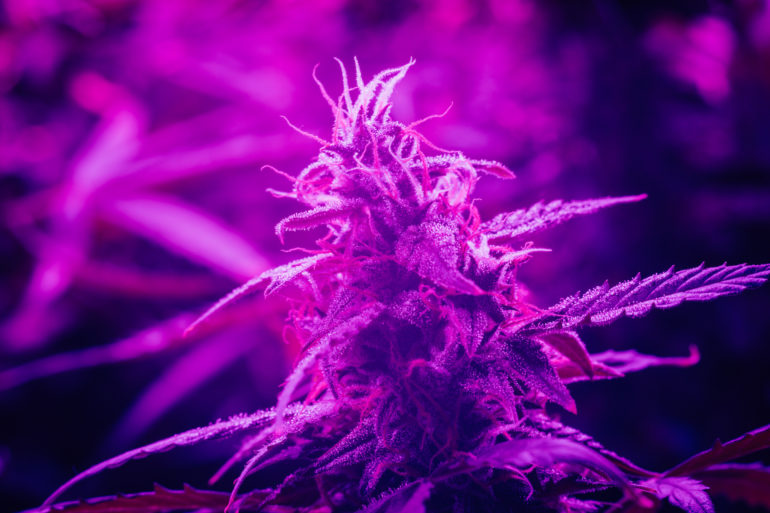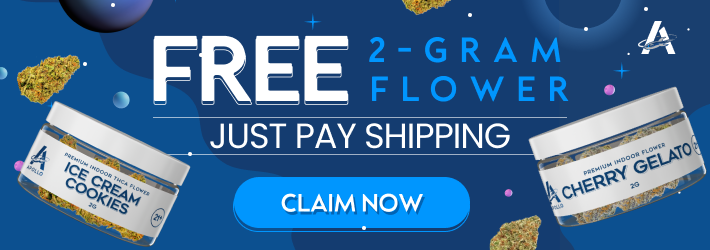THC-C1 is the shortest form of THC in existence. Because it only has 1 carbon to play with, THC-C1 can’t bind to CB1 or CB2 like THC does. This means THC-C1 won’t get you high nor cause THC’s physiologic effects as you might expect.
THC-C1 does, however, have significant activity with a family of non-CB receptors that are involved with pain, inflammation, and neuronal health. To date, no clinical studies have demonstrated the potential benefits or side effects of THC-C1.
Without CB activity, THC-C1 side effects probably lie closer to those of CBD and other non-intoxicating, minor cannabinoids.
What Is THC-C1?

THC-C1 goes by many names including Δ9-tetrahydrocannabiorcol, C16, THCC, or just tetrahydrocannabiorcol. It’s naturally found in the pollen of male cannabis plants, contrary to the majority of cannabinoids commonly found in female plants.
THCC is what’s called an “orcinoid” cannabinoid, meaning it has a 1-carbon tail (alkyl side chain). Unlike THCV which has 3 carbons and THC which has 5, THCC ranks in this unique class of non-intoxicating cannabinoids.
Orcinoids are exceedingly rare and only made in trace amounts in cannabis, while Rhododendron plants make lots. THCC products in retail and the lab are semisynthetic.
THC-C1 vs. THC: Key Differences
- THC works directly on CB receptors, which causes many psychological side effects like euphoria, intoxication, anxiety, and cognitive impairment – while THC-C1 does not
- In excess, THC can also cause known physical side effects. THC-C1 probably doesn’t share these, but its overall effects remain to be seen
- THC-C1 may be a stronger TRPA1 agonist and help with pain while avoiding impairing effects associated with THC, but no clinical data exists, in contrast to THC
- THC is naturally and abundantly available in state-legal dispensaries, while marketplace THC-C1 is semisynthetic and treated like other retail hemp-derived products
THC-C1 vs. CBD: Key Differences
- CBD is all-natural, and THC-C1 is as well but mass production calls for semisynthesis of THC-C1 to meet consumer demand
- CBD and THC-C1 are non-intoxicating and seem to lack adverse psychological side effects, with CBD so far as reducing THC’s psychoactivity, but THC-C1 needs documented testing
- CBD is known to act on the same TRP plus many other receptors that can enhance our mood and health
- CBD and THC-C1 share possible pain-relieving, immune-modifying, and neuroprotective effects, but there is a mountain of clinical data including FDA approval for CBD, but none for THC-C1
What Are the Benefits and Effects of THC-C1?

Currently, THCC is only known in a few, small preclinical studies for its potential pain-relieving, immune-modifying, and neuron-supporting activity via the TRP receptor family. Cannabinoids in general are well-known to universally interact with the TRP family to deliver these kinds of health benefits in more familiar cannabinoids like CBD and THC. When it comes to THCC specifically, it may be:
- Pain-relieving – In ways similar to acetaminophen (Tylenol®) and THC but without the associated toxicities
- Immune-boosting – Works on receptors involved in adaptive and innate immunity
- Neuron-supportive – TRP channels on spinal cord neurons may benefit from THCC as they generally do from cannabinoids
On the surface, THCC may be advantageous but so far it has not been clinically studied so nothing is certain yet.
What Are the Side Effects of THC-C1?
Unfortunately, the only preclinical study in existence did not examine side effects in live mice. But we know that the minimal length of the side tail means THCC doesn’t appreciably interact with CB1 nor CB2 receptors as you’d expect. Instead, we may reasonably anticipate that THCC could be well-tolerated and carry milder side effects closer to those of CBD oil, including:
- Diarrhea
- GI or upper respiratory disturbances
- Drowsiness
- Sedation
- Certain medication interactions (e.g. antiepileptics)
How Much THC-C1 Should You Take?
Right now, there isn’t any data to suggest how much THCC you should take. Given that it is a non-intoxicating and experimental cannabinoid, it should likely be dosed as such.
This means you may reasonably start with two to four puffs every one to two hours to gauge its effects. If edible or oral, try a single dose of 5-10 mg and wait 3-4 hours to fully gauge its effects on you.
As you gain comfort experimenting with THCC, you may adjust your own dose accordingly or ask your healthcare provider or a cannabis coach.
Will THC-C1 Get You High?
No, THC-C1 cannot get you high. Unlike THC, the 1-carbon tail of THCC doesn’t appreciably interact with CB1 receptors to cause a high. This is one of the few things we do know about THCC.
Modern research shows us that the longer the tail, the more psychoactive that form of THC is. This puts THC-C1 at the non-intoxicating end of the spectrum, and newly discovered compounds like THCP at the top of psychoactivity.
Still, we don’t know if THC-C1 interacts with the other components of the endocannabinoid system (ECS) or eCBome to change our mood or mental health. Cannabinoids can influence good feelings and well-being from within and outside the ECS through a variety of eCBome receptors like serotonin, dopamine, and more.
Will THC-C1 Show Up on a Drug Test?
Likely yes, THC-C1 could trigger a positive result. Even though this molecule isn’t directly looked for, THC-C1 and its metabolites are similar enough to THC’s that it may trigger a positive test.
According to drug screening data on THC and similar cannabinoids, there was a high co-prevalence of THCV and its metabolite, THCV-COOH, in samples. Since THCV has 3 carbons and THCC has just 1, there may be similar probabilities that these compounds and metabolites can show up in drug testing.
Conclusion
THCC represents yet another non-psychoactive form of THC that may be clinically useful, but we need more information. Research pushing orcinoid cannabis science further is warranted.
References
- Andersson, D. A., Gentry, C., Alenmyr, L., Killander, D., Lewis, S. E., Andersson, A., Bucher, B., Galzi, J.-L., Sterner, O., Bevan, S., Högestätt, E. D., & Zygmunt, P. M. (2011). TRPA1 mediates spinal antinociception induced by acetaminophen and the cannabinoid Δ9-tetrahydrocannabiorcol. Nature Communications, 2(1), Article 1. https://doi.org/10.1038/ncomms1559
- Benavides, A. (2023, May 24). Piecing Together the Endocannabinoidome: Charting the Next Frontier. Cannabis Central. https://www.veriheal.com/blog/piecing-together-the-endocannabinoidome-charting-the-next-frontier/
- Bow, E. W., & Rimoldi, J. M. (2016). The Structure–Function Relationships of Classical Cannabinoids: CB1/CB2 Modulation. Perspectives in Medicinal Chemistry, 8, 17–39. https://doi.org/10.4137/PMC.S32171
- Citti, C., Linciano, P., Russo, F., Luongo, L., Iannotta, M., Maione, S., Laganà, A., Capriotti, A. L., Forni, F., Vandelli, M. A., Gigli, G., & Cannazza, G. (2019). A novel phytocannabinoid isolated from Cannabis sativa L. with an in vivo cannabimimetic activity higher than Δ9-tetrahydrocannabinol: Δ9-Tetrahydrocannabiphorol. Scientific Reports, 9(1), Article 1. https://doi.org/10.1038/s41598-019-56785-1
- Ebbert, J. O., Scharf, E. L., & Hurt, R. T. (2018). Medical Cannabis. Mayo Clinic Proceedings, 93(12), 1842–1847. https://doi.org/10.1016/j.mayocp.2018.09.005
- Hanuš, L. O., Meyer, S. M., Muñoz, E., Taglialatela-Scafati, O., & Appendino, G. (2016). Phytocannabinoids: A unified critical inventory. Natural Product Reports, 33(12), 1357–1392. https://doi.org/10.1039/C6NP00074F
- Madeo, G., Kapoor, A., Giorgetti, R., Busardò, F. P., & Carlier, J. (2023). Update on Cannabidiol Clinical Toxicity and Adverse Effects: A Systematic Review. Current Neuropharmacology. https://doi.org/10.2174/1570159X21666230322143401
- Moparthi, L., Survery, S., Kreir, M., Simonsen, C., Kjellbom, P., Högestätt, E. D., Johanson, U., & Zygmunt, P. M. (2014). Human TRPA1 is intrinsically cold- and chemosensitive with and without its N-terminal ankyrin repeat domain. Proceedings of the National Academy of Sciences of the United States of America, 111(47), 16901–16906. https://doi.org/10.1073/pnas.1412689111
- National Academies of Sciences, E., Division, H. and M., Practice, B. on P. H. and P. H., & Agenda, C. on the H. E. of M. A. E. R. and R. (2017). Therapeutic Effects of Cannabis and Cannabinoids. In The Health Effects of Cannabis and Cannabinoids: The Current State of Evidence and Recommendations for Research. National Academies Press (US). https://www.ncbi.nlm.nih.gov/books/NBK425767/
- Ross, S. A., ElSohly, M. A., Sultana, G. N. N., Mehmedic, Z., Hossain, C. F., & Chandra, S. (2005). Flavonoid glycosides and cannabinoids from the pollen of Cannabis sativa L. Phytochemical Analysis, 16(1), 45–48. https://doi.org/10.1002/pca.809
- Vikingsson, S., Hart, E. D., Winecker, R. E., Cone, E. J., Kuntz, D. J., Clark, M., Jacques, M., Hayes, E. D., & Flegel, R. R. (2023). Prevalence of ∆8-tetrahydrocannabinol carboxylic acid in workplace drug testing. Journal of Analytical Toxicology, bkad068. https://doi.org/10.1093/jat/bkad068
- Walsh, K. B., McKinney, A. E., & Holmes, A. E. (2021). Minor Cannabinoids: Biosynthesis, Molecular Pharmacology and Potential Therapeutic Uses. Frontiers in Pharmacology, 12, 777804. https://doi.org/10.3389/fphar.2021.777804
- Zhang, L., Simonsen, C., Zimova, L., Wang, K., Moparthi, L., Gaudet, R., Ekoff, M., Nilsson, G., Hellmich, U. A., Vlachova, V., Gourdon, P., & Zygmunt, P. M. (2022). Cannabinoid non-cannabidiol site modulation of TRPV2 structure and function.Nature Communications, 13(1), Article 1. https://doi.org/10.1038/s41467-022-35163-y

